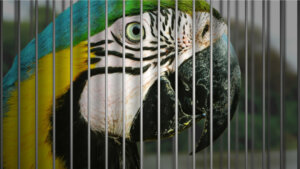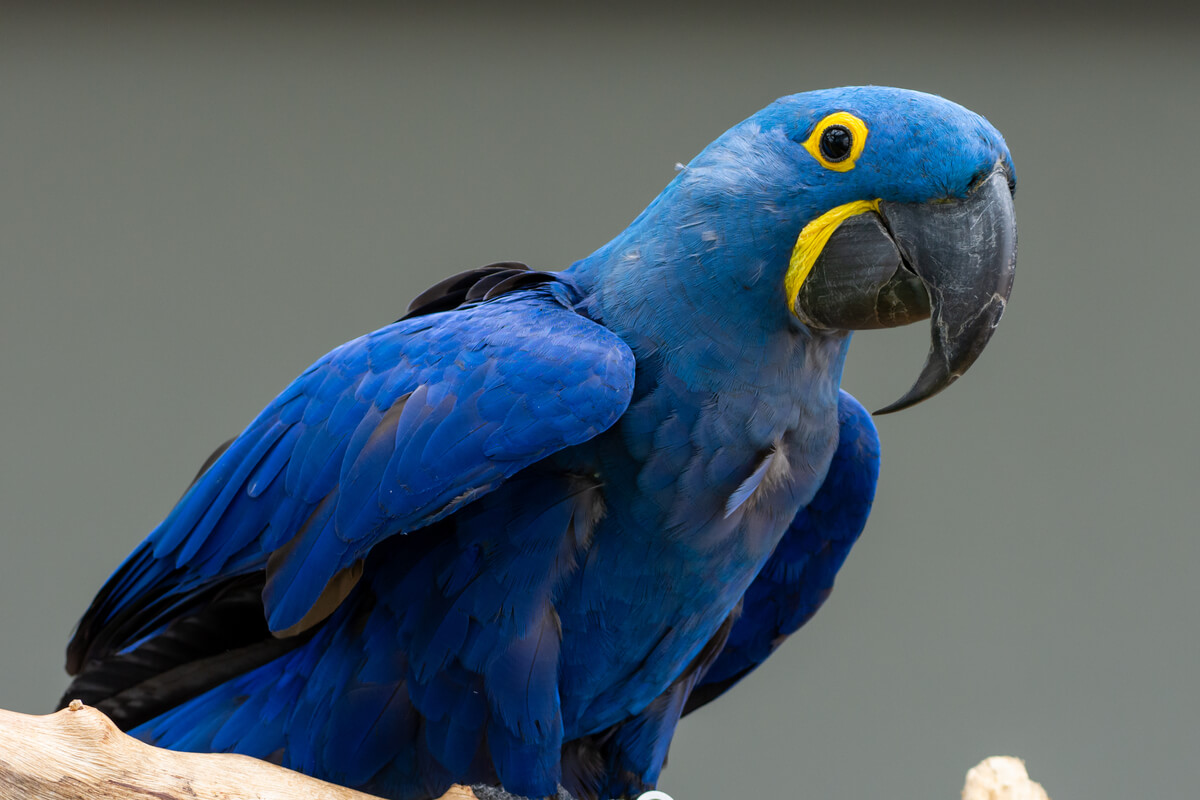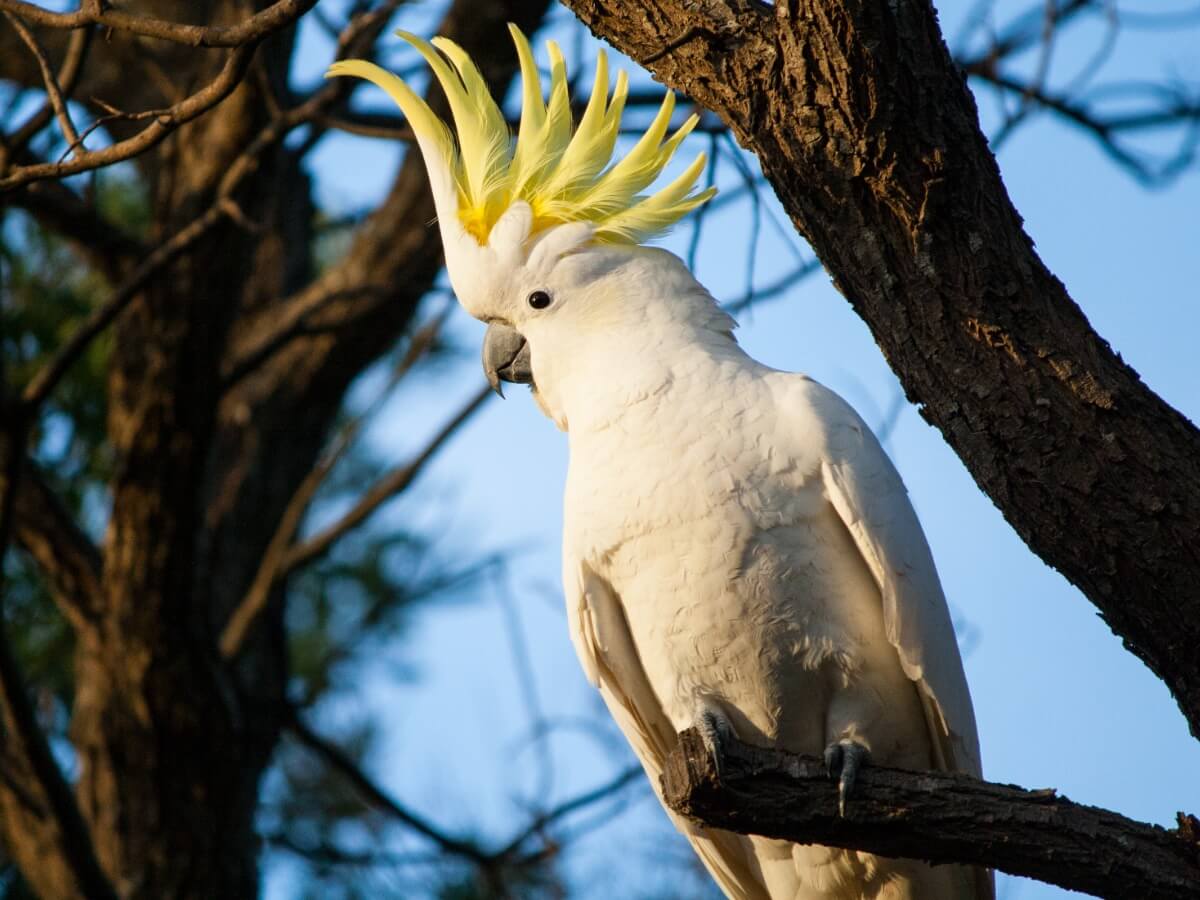7 Domestic Birds in Danger of Extinction


Written and verified by the biologist Francisco Morata Carramolino
Although it isn’t something that many take into account when obtaining a companion animal, many of the living beings that are marketed as pets are taken from their natural surroundings, especially the exotic ones. Not only this, but the process by which they’re sourced and delivered to stores is often cruel and unethical. Because of these practices, there are many birds in danger of extinction in the wild.
It’s even more serious than this, because pet trafficking is one of the main threats to wildlife today. In addition, many of these stolen animals aren’t domestic. This means that they haven’t gone through the long process of adaptation to life among humans and, because of that, they don’t usually make good pets.
As a consequence of the demand for exotic bird species, several of the so-called “domestic birds” are in danger of extinction in their natural environments. Parrots have been especially impacted by this illegal trade. In this article, we’ll talk about these birds and their associated problems. Read on to find out more!
1. African gray parrot (Psittacus erithacus)
This is undoubtedly one of the most popular domestic bird species, but this fame has put African gray parrots in grave danger. Around 21% of the total population of these parrots is caught from their natural habitat in central and western Africa, to be sold as pets.
It is estimated that up to 100,000 gray parrots per year are taken from some areas of Africa. Coupled with the destruction of the forests these animals call home, this could cause Psittacus erithacus populations to plummet for generations to come.

2. Spix’s macaw (Cyanopsitta spixii)
This macaw suffered a very similar case to the previous one, but even worse. The species used to live in Brazil, but its populations were affected by the destruction of its forests after the European colonization of the area.
After that, the Spix’s macaws were completely eliminated from their ecosystems by the pet trade. Currently, there are some specimens in captivity, but they’re extinct in the wild.
3. Javanese rice cappuccino (Lonchura oryzivora)
The problem of domestic birds isn’t only limited to parrots, as many other birds are also in danger. This beautiful species, with a pastel livery and a wide red bill, is an example of this.
Lonchura oryzivora used to be very abundant on the islands of Bali, Java and Madura in Indonesia. Unfortunately, its capture for local and international trade is making it increasingly rare. These animals have gregarious habits, which allows large masses of birds to be captured at the same time and costs are reduced.

4. Cobalt macaw (Anodorhynchus leari)
The story of this blue bird exemplifies the clear impact that the pet trade has. The capture of animals reduced the populations of these “domestic” birds considerably. Eventually, they were classified as “critically endangered” by the International Union for Conservation of Nature (IUCN) between 1994 and 2008.
Although these macaws are still considered to be threatened, their numbers are increasing progressively since intensive measures were implemented that have stopped the hunting. Luckily, there is still hope for this beautiful bird.

5. Cardinal (Spinus cucullatus)
This is a striking black and red bird, native to Venezuela, Guyana and Colombia. It has suffered enormous and prolonged pressure from hunters, as it’s capable of hybridizing with canaries (Serinus canaria). This produces the red color in domestic canary breeds, which is in high demand.
Consequently, the populations of these finches have been reduced, fragmented and it has become locally extinct. Today, the species is very rare.
6. Saker falcon (Falco cherrug)
This is a very different bird from the previous ones, threatened by a different form of keeping wild animals. The saker falcon is in danger due to the destruction of its habitats, mortality from human infrastructures, and, to a large extent, falconry.
Falconers – hunters who use raptors to kill wild animals – have been a serious problem for this animal. It’s estimated that between 6,800 and 8,400 hawks have been caught per year in their area. Especially females are abducted, which produces a detrimental bias between the sexes.

7. Sulfur cockatoo (Cacatua sulphurea)
Cockatoos are very charismatic animals, intelligent, expressive and capable of using tools. Unfortunately, a considerable number of these birds are threatened.
The sulfur cockatoo, known for its white body and yellow crest, has one of the most unfavorable situations, as it’s considered by the IUCN as “critically endangered”. This precarious state is almost exclusively due to hunting for sale as a pet.

All these species and many others – such as the yellow-headed parrot and the sun parakeet – are clear examples of the dangers of unethical animal ownership. Because of this, pets that don’t come from long lines of captive breeding should never be obtained. It’s in everyone’s hands to avoid the trafficking of living beings and help these birds in danger.
Although it isn’t something that many take into account when obtaining a companion animal, many of the living beings that are marketed as pets are taken from their natural surroundings, especially the exotic ones. Not only this, but the process by which they’re sourced and delivered to stores is often cruel and unethical. Because of these practices, there are many birds in danger of extinction in the wild.
It’s even more serious than this, because pet trafficking is one of the main threats to wildlife today. In addition, many of these stolen animals aren’t domestic. This means that they haven’t gone through the long process of adaptation to life among humans and, because of that, they don’t usually make good pets.
As a consequence of the demand for exotic bird species, several of the so-called “domestic birds” are in danger of extinction in their natural environments. Parrots have been especially impacted by this illegal trade. In this article, we’ll talk about these birds and their associated problems. Read on to find out more!
1. African gray parrot (Psittacus erithacus)
This is undoubtedly one of the most popular domestic bird species, but this fame has put African gray parrots in grave danger. Around 21% of the total population of these parrots is caught from their natural habitat in central and western Africa, to be sold as pets.
It is estimated that up to 100,000 gray parrots per year are taken from some areas of Africa. Coupled with the destruction of the forests these animals call home, this could cause Psittacus erithacus populations to plummet for generations to come.

2. Spix’s macaw (Cyanopsitta spixii)
This macaw suffered a very similar case to the previous one, but even worse. The species used to live in Brazil, but its populations were affected by the destruction of its forests after the European colonization of the area.
After that, the Spix’s macaws were completely eliminated from their ecosystems by the pet trade. Currently, there are some specimens in captivity, but they’re extinct in the wild.
3. Javanese rice cappuccino (Lonchura oryzivora)
The problem of domestic birds isn’t only limited to parrots, as many other birds are also in danger. This beautiful species, with a pastel livery and a wide red bill, is an example of this.
Lonchura oryzivora used to be very abundant on the islands of Bali, Java and Madura in Indonesia. Unfortunately, its capture for local and international trade is making it increasingly rare. These animals have gregarious habits, which allows large masses of birds to be captured at the same time and costs are reduced.

4. Cobalt macaw (Anodorhynchus leari)
The story of this blue bird exemplifies the clear impact that the pet trade has. The capture of animals reduced the populations of these “domestic” birds considerably. Eventually, they were classified as “critically endangered” by the International Union for Conservation of Nature (IUCN) between 1994 and 2008.
Although these macaws are still considered to be threatened, their numbers are increasing progressively since intensive measures were implemented that have stopped the hunting. Luckily, there is still hope for this beautiful bird.

5. Cardinal (Spinus cucullatus)
This is a striking black and red bird, native to Venezuela, Guyana and Colombia. It has suffered enormous and prolonged pressure from hunters, as it’s capable of hybridizing with canaries (Serinus canaria). This produces the red color in domestic canary breeds, which is in high demand.
Consequently, the populations of these finches have been reduced, fragmented and it has become locally extinct. Today, the species is very rare.
6. Saker falcon (Falco cherrug)
This is a very different bird from the previous ones, threatened by a different form of keeping wild animals. The saker falcon is in danger due to the destruction of its habitats, mortality from human infrastructures, and, to a large extent, falconry.
Falconers – hunters who use raptors to kill wild animals – have been a serious problem for this animal. It’s estimated that between 6,800 and 8,400 hawks have been caught per year in their area. Especially females are abducted, which produces a detrimental bias between the sexes.

7. Sulfur cockatoo (Cacatua sulphurea)
Cockatoos are very charismatic animals, intelligent, expressive and capable of using tools. Unfortunately, a considerable number of these birds are threatened.
The sulfur cockatoo, known for its white body and yellow crest, has one of the most unfavorable situations, as it’s considered by the IUCN as “critically endangered”. This precarious state is almost exclusively due to hunting for sale as a pet.

All these species and many others – such as the yellow-headed parrot and the sun parakeet – are clear examples of the dangers of unethical animal ownership. Because of this, pets that don’t come from long lines of captive breeding should never be obtained. It’s in everyone’s hands to avoid the trafficking of living beings and help these birds in danger.
All cited sources were thoroughly reviewed by our team to ensure their quality, reliability, currency, and validity. The bibliography of this article was considered reliable and of academic or scientific accuracy.
- https://www.birdlife.org/worldwide/policy/wild-bird-trade-and-cites
- https://www.audubon.org/news/the-illegal-parrot-trade
- https://www.nationalgeographic.com/magazine/article/photo-ark-parrots
- https://awionline.org/content/bird-trade
- BirdLife International. 2018. Psittacus erithacus. The IUCN Red List of Threatened Species 2018: e.T22724813A129879439.
- BirdLife International. 2019. Cyanopsitta spixii. The IUCN Red List of Threatened Species 2019: e.T22685533A153022606.
- BirdLife International. 2018. Lonchura oryzivora. The IUCN Red List of Threatened Species 2018: e.T22719912A131809903.
- BirdLife International. 2020. Anodorhynchus leari (amended version of 2019 assessment). The IUCN Red List of Threatened Species 2020: e.T22685521A176030480.
- BirdLife International. 2018. Spinus cucullatus. The IUCN Red List of Threatened Species 2018: e.T22720374A132138099.
- BirdLife International. 2017. Falco cherrug (amended version of 2016 assessment). The IUCN Red List of Threatened Species 2017: e.T22696495A110525916.
- BirdLife International. 2018. Cacatua sulphurea. The IUCN Red List of Threatened Species 2018: e.T22684777A131874695.
This text is provided for informational purposes only and does not replace consultation with a professional. If in doubt, consult your specialist.








